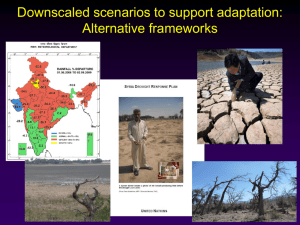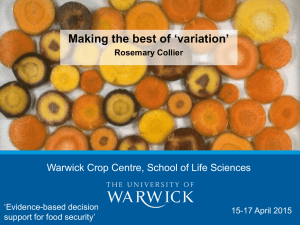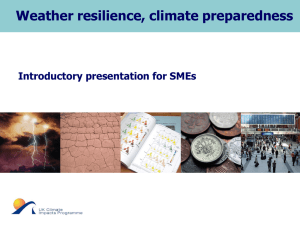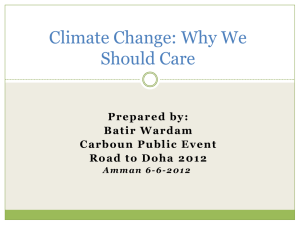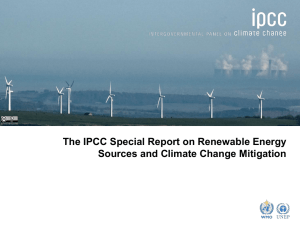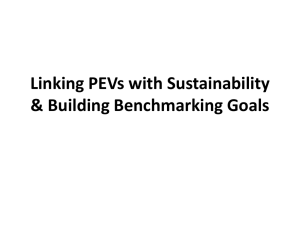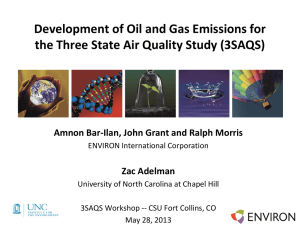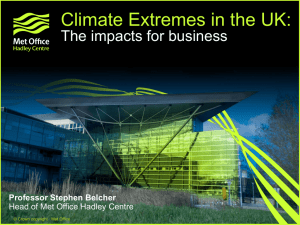Use of probabilistic climate change information for impact
advertisement
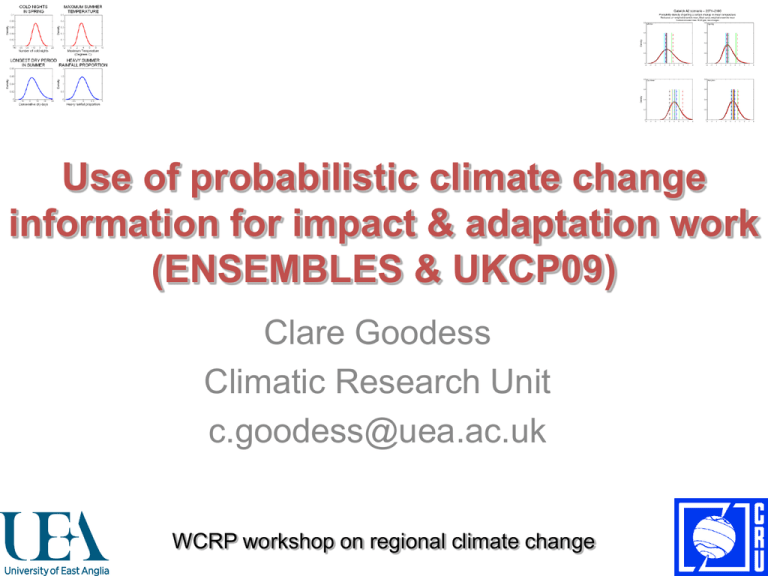
Use of probabilistic climate change information for impact & adaptation work (ENSEMBLES & UKCP09) Clare Goodess Climatic Research Unit c.goodess@uea.ac.uk WCRP workshop on regional climate change ENSEMBLES regional scenarios portal www.cru.uea.ac.uk/projects/ensembles/ScenariosPortal Some examples of PDFs All these PDFs are conditional (on A1B, underlying assumptions….) And subjective – do not sample the ‘full’ uncertainty range............. Some ENSEMBLES conclusions: • ‘Subjective’ not ‘objective’ probabilities • Users need to know underlying inputs, assumptions & methods • Underlying assumptions tend to be harder to explain & understand than for deterministic scenarios • A wide PDF does not mean that all uncertainties have been extensively or uniformly sampled • Good communication & user guidance are essential UKCP09 national climate change projections probabilistic projections over land weather monthly/ generator daily seasonal time PDFs series http://ukclimateprojections.defra.gov.uk/ PDFs summer Tmax, East of England, 2020s & 2050s CDFs summer Prec, East of England, 2020s & 2050s Users preferred numbers to graphs – but not too many......... Summary of UKCP09 projected changes for the East of England administrative region. 10%, 50% and 90% probability estimates are given for the medium emissions scenario. The Wider Range indicates the 10% to 90% range across the low to high emissions scenario (each of which are considered as equally likely as the medium emissions scenario). Temperature changes in °C, precipitation changes in %. UKCP09 key messages: Under medium emissions for the 2050s, the central estimate of increase in summer mean daily maximum temperature is 3.4°C; it is very unlikely to be less than 1.3°C & is very unlikely to be more than 6.0°C. A wider range of uncertainty is from 1.1°C to 6.8°C. Under medium emissions for the 2050s, the central estimate of change in summer mean precipitation is -17%; it is very unlikely to be less than -38% & is very unlikely to be more than +6%. A wider range of uncertainty is from -40% to +14%. • Zero or very small changes in annual precipitation (rainfall and snow) mask contrasting seasonal changes: with wetter winters & drier summers. In spring, the most likely change (i.e., the 50% probability – or the mode/peak of the PDF) is ‘no change’, i.e., zero, with some indication of a rather small increase in autumn. • The central estimate for the medium emissions scenario is -7% in summer, with the change likely to be between a 24% reduction & a 15% increase for the 2020s. For the 2050s, the central estimate for the medium emissions scenario is -17% in summer. The wider range indicates that the summer decrease is very unlikely to be more than -40%, although the upper range is positive (+14%). • Another, and perhaps simpler, way of expressing the summer changes is that, for the 2020s there is a 60 to 70% probability that total summer rainfall will decrease, rising to 74 to 85% probability for the 2050s. Indices based on UKCP09 weather generator output (100 x 30 years – sampled change factors from PDFs) Changes in counts of GDD (growing degree days) for Lowestoft. The left plot shows the increase in mean annual values (with upper and lower 95% confidence intervals) for the 2020s (medium emissions) and 2050s (low, medium and high emissions). The right plot shows the seasonal increase in mean values for the 2050s (medium emissions – red boxes) relative to the baseline period (purple boxes). The variation in counts is shown by the upper and lower edges of the boxes (1 standard deviation above and below the mean) and the T ‘whiskers’ (2 standard deviations above and below the mean). Wider maximum and minimum values are represented by black crosses. Design Summer Years (DSYs) and Test Reference Years (TRYs) for use in building performance models DSY: April-Sept mean T Middle of the upper quartile TRY: The most ‘normal’ year selected for each month Challenges for the community: • Current DSYs/TRYs don’t represent the present CIBSE TM36, 2005 • Need to handle climate variability as well as change • Need to work with uncertainty (e.g.,multiple emissions scenarios) • And now need to work with probabilities (UKCP02 to UKCP09) • Range of ‘users’: engineers/consultants, architects & their clients DSYs from UKCP09 weather generator output 100 x 30 years London Medium emissions Method 1: Calculate the metric for each 30 year period & then take 50th percentile of 100 values Method 2: Calculate 50th percentile from 3000 metric values Dashed lines: CIBSE TM48 Solid lines: UKCP09 wgen Thanks to Vic Hanby & Stefan Thor Smith EPSRC PROCLIMATION project, DMU There are benefits in using probabilistic projections, but...... WCRP workshop on regional climate change
